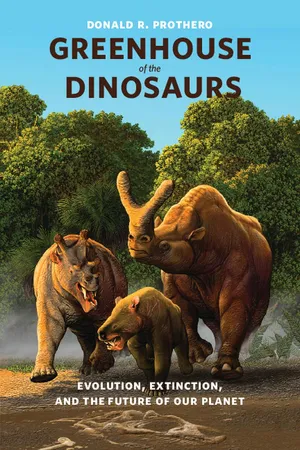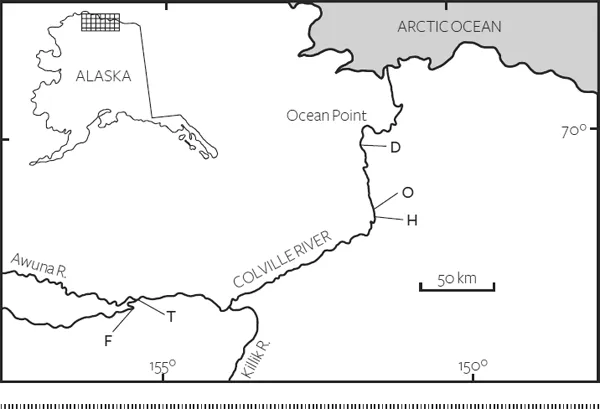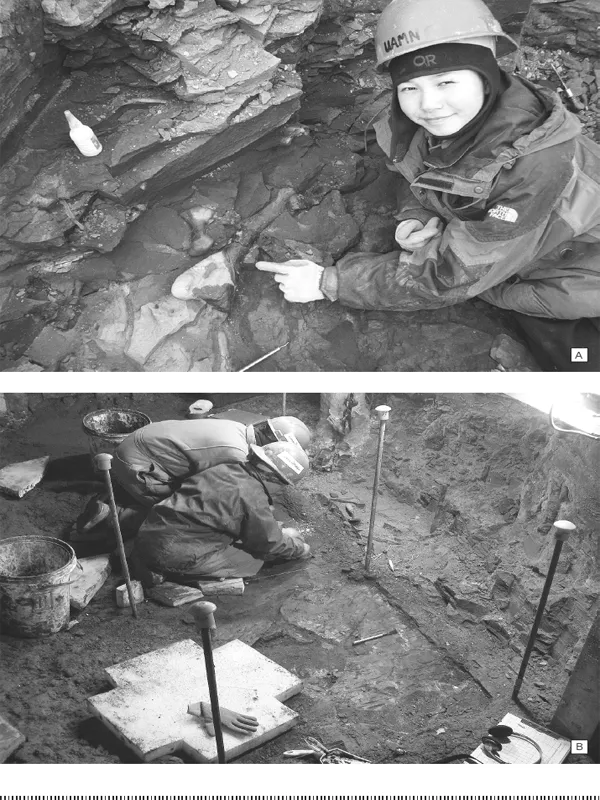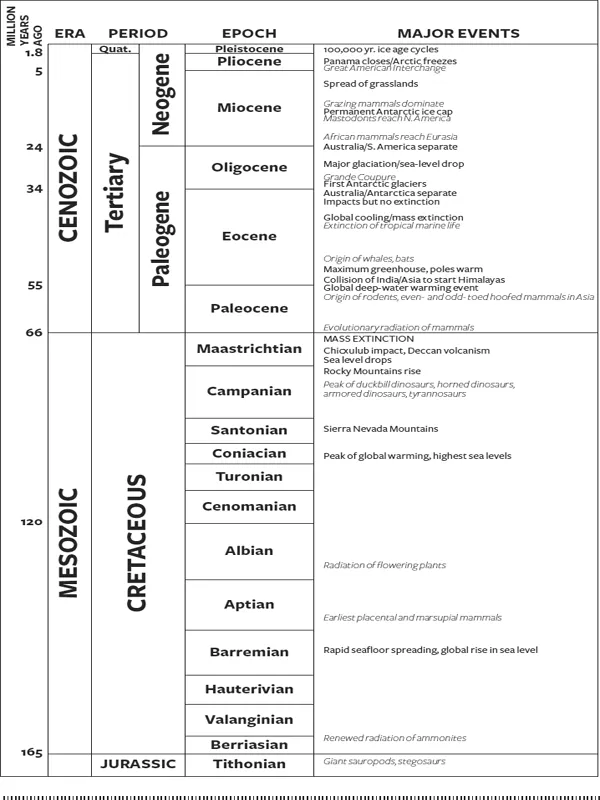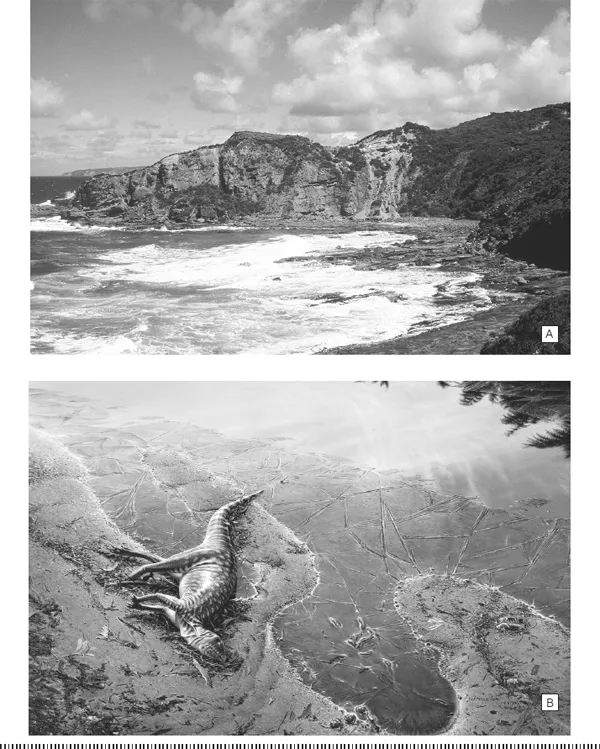![]()
1 | Greenhouse of the Dinosaurs
The heat of European latitudes during the Eocene period … seem[s] … equal to that now experienced between the tropics.
—CHARLES LYELL, PRINCIPLES OF GEOLOGY
Dinosaurs of the Arctic Jungles
When one thinks of dinosaurs, the first image that pops into mind is that of huge sauropods wandering through warm, lush jungles of conifers and cycads or Triceratops and Tyrannosaurus rex battling it out in a landscape populated by magnolias and other primitive flowering plants. We hear about the warm climates and dense vegetation of the age of dinosaurs and of the discovery of their remains in tropical and temperate latitudes from Montana to Mongolia to Malawi. Even though Mongolia and Montana are now harsh high-altitude deserts or steppes with blazing hot summers and extremely cold winters, their transformation into the lush landscape of the Mesozoic doesn’t seem beyond the realm of possibility. In the past 20 years, however, one of the more astounding discoveries is the revelation that dinosaurs were abundant even in the polar regions above the Arctic and Antarctic circles, where they would have experienced six months of darkness (see the illustration that opens this chapter).
The first evidence of this amazing discovery was accidental and almost completely overlooked. Exploring along the Colville River (figure 1.1) on Alaska’s North Slope in 1961, a geologist named R. L. Liscomb was mapping rocks for Shell Oil Company and assessing their oil potential, not looking for fossils. He found and collected some huge bones eroding out of the banks of the Colville River. Not unreasonably, he assumed they were from Ice Age mammals, which are found in abundance in the Arctic region. In 1978, another geologist, R. E. Hunter, found clear dinosaur footprints near Big Lake on the Alaska Peninsula. Finally, in 1984 the legendary paleontologist C. A. “Rep” Repenning of the U.S. Geological Survey (USGS) reexamined the bones collected by Liscomb 23 years earlier and realized they were dinosaur bones. (Rep was a good friend of mine and of most vertebrate paleontologists. In 2005, he was tragically murdered in his own home near Denver by a thief who thought he had commercially valuable fossils in his possession.) The announcement of these dinosaur fossils impelled a number of expeditions by paleontologists and geologists to revisit the Colville site and relocate the dinosaur bones in the 1980s and 1990s, all led by Dr. William Clemens from the Museum of Paleontology at the University of California at Berkeley and Dr. Roland Gangloff of the University of Alaska at Fairbanks. Their discovery was startling—thousands of dinosaur bones (figure 1.2) eroding from the riverbanks for miles along the Colville River, 200 miles north of the Arctic Circle! In 2007, paleontologists even dug a tunnel into the riverbank (figure 1.3) to excavate the bone bed in greater depth and to recover better-preserved bones that had not been shattered by the freezing and thawing of the permafrost near the surface. The Colville River bones came from the end of the age of dinosaurs, the latest Cretaceous period (for the timescale, see figure 1.3), about 69 million years old, and some of the dinosaur tracks there date to the middle part of the Cretaceous, about 90 to 110 million years ago.
The Colville River localities have yielded at least 12 different species of dinosaurs so far, with the most abundant being the huge 13-meter (40-foot), three-ton duckbilled dinosaurs known as Edmontosaurus. Two other duckbilled dinosaurs, the large-nosed Kritosaurus and the large-crested Lambeosaurus, are also known from the area. Next in abundance are the horned dinosaurs, or ceratopsians, including Pachyrhinosaurus, with its thick, flat horn boss on the nose and broad frill, and the three-horned Anchiceratops, which looked vaguely like Triceratops but was more primitive. There were also pachycephalosaurs, smaller bipedal dinosaurs that had a thick dome of bone in their skull caps that protected their brain. The function of the thick dome is still controversial, although most paleontologists believe it was used for head-butting combat between males of the same species. A tyrannosaur would certainly make an easy meal of a 5-meter (15-foot) pachycephalosaur with no other armor! Finally, there was the ostrichlike herbivorous dinosaur Thescelosaurus, which was about 3 meters (11 feet) long and weighed about 90 kilograms (200 pounds).
FIGURE 1.1 The Colville River dinosaur localities on the North Slope of Alaska. F = footprint; D = femur; T = turtle and tooth-marked clam; O = occipital condyle; H = horn core. (Redrawn from Parrish et al. 1987)
FIGURE 1.2 In the Liscomb bone bed, (A) Kelly May of the University of Alaska Museum of the North excavates a hadrosaur tibia, and (B) museum team members excavate hadrosaur material in a permafrost tunnel. (Photographs courtesy K. C. May, University of Alaska Museum of the North)
FIGURE 1.3 Mesozoic and Cenozoic timescale. Climatic events are in boldface; biotic, in italics.
The predators include the familiar T. rex (known only from a single tooth so far), and a slightly smaller tyrannosaur, Albertosaurus, which is better known from southern Alberta (hence its name). There were also the small lightweight predators known as dromaeosaurs, such as Troodon, Dromaeosaurus, and Saurornitholestes, which looked much like the “raptors” of Jurassic Park fame. All of these dinosaurs are known from beautiful complete skeletons in the Upper Cretaceous Red Deer River badlands of Alberta, so dinosaurs apparently roamed easily between southern Alberta and northern Alaska in the Late Cretaceous.
Today the Colville River sites are only a short distance from the Arctic Ocean and are frozen over from October to May, with temperatures averaging–16°C (–27°F) in January. Even the brief summer is cold and dry, with highs only about 8°C (46°F) and lows around freezing each night. Nothing grows there today except tundra plants, which are adapted to freezing most of the year and must grow rapidly during the short summer months. Finally, the sites are hundreds of miles north of the Arctic Circle and were so during the Cretaceous as well, so the area experienced four to six months of darkness every year. Clearly, the modern climate and vegetation could not support such a huge diversity of large herbivorous dinosaurs, and today the region has only herds of caribou, musk oxen, and Arctic rodents and rabbits.
Indeed, abundant fossil plant remains are preserved not only in the Cretaceous rocks of the Colville River area, but also in eastern Siberia. Most of the plants were conifers, such as the relatives of the living Taxodium (bald cypress), which today are most abundant in the temperate-subtropical wetlands such as the Okefenokee Swamp, the Everglades, and the Mississippi Delta. During the Cretaceous, there were also abundant cycads (“sego palms,” which are actually gymnosperms and not true palm trees). These cycads were more vinelike than their modern stumpy palmlike relatives and may have carpeted the landscape. Another gymnosperm, the ginkgo (“maidenhair”) tree, was very abundant, as were numbers of smaller flowering plants. Based on their spores, ferns grew in great abundance in the understory of these conifers, as did sphenopsids (scouring rushes or horsetails) in the wetter areas. In short, this plant assemblage was a mixture of swampy vegetation with drier upland forests, not too different from the plants in the warm temperate latitudes of North America today—and nothing like the plants that grow in the modern climate of Alaska.
An analysis of the shapes of the fossil leaves gives a mean annual temperature of 5°C (41°F), with summer temperatures above 10°C (50°F) and winter temperatures at or below freezing (Parrish et al. 1987; Spicer and Parrish 1990). Nevertheless, the tree rings of the logs show strong patterns of seasonal growth, with no growth during the four months of darkness. Nearly all the plants were deciduous and dropped their leaves during the warm, dark winters or died off, as do ferns. So even though the climate was much warmer than it is today, the dark winter landscape would have had almost no fresh green plant food available for the herbivorous dinosaurs to eat.
Paleontologists have long puzzled over how such conditions would permit such a high diversity of dinosaurs. Most think that the dinosaurs migrated up from the south during the summer and back down from the north during the winter. This hypothesis is consistent with the fact that none of the dinosaur bones shows growth rings indicative of slow growth during the winter dormancy. Most of the dinosaurs were large and mobile, and their fossils have been found from Mongolia and China to southern Texas, so they clearly could walk long distances. However, there are also very small dinosaur teeth in the North Slope faunas, suggesting that smaller nonmigratory dinosaurs were also present, or even juvenile dinosaurs that must somehow have shut down their metabolisms and toughed it out for four months of darkness and near starvation.
Dinosaurs of Darkness Down Under
Almost the same story can be told about the Southern Hemisphere in the Cretaceous. Although the Southern Hemisphere dinosaurs are not as abundant as they are in the Arctic, nevertheless there are some important Cretaceous finds here. The first dinosaur fossil finds in Australia were made in 1903 by the pioneering Australian geologist William Hamilton Ferguson, who found a dinosaur claw. Since 1984, my friends Tom Rich of the Victoria Museum in Australia and Patricia Vickers-Rich of Monash University have been working on the problem. Both Tom and Pat were students of my graduate adviser, Malcolm McKenna, at Columbia University. They finished their doctorates in 1973, just a few years before I arrived in the program, and then took positions in Australia. Every austral summer or fall they lead crews to the beach of Inverloch, Victoria, Australia, about 145 kilometers (90 miles) southeast of Melbourne. At a site known as Dinosaur Cove (figure 1.4A), they use dynamite and heavy equipment to tunnel into the overlying beach cliff, then rock saws and large hammers to remove the hard blocks of fossiliferous sandstone and chisel out the precious dinosaur fossils. Years of hard labor have produced a great number of dinosaur fossils, including the little hypsilophodontids Leaellynasaura amicagraphica (figure 1.4B) and Atlascopcosaurus loadsi, the small predatory coelurosaur Timimus hermani, and ostrichlike oviraptorid dinosaurs as well. Two of these dinosaurs were named for the Riches’ children, Leaellyn and Tim.
FIGURE 1.4 Dinosaur Cove in (A) the present and (B) the Cretaceous, with the carcass of Leaellynasaura amicagraphica about to be fossilized. ([A] photograph courtesy T. Rich; [B] painting by P. Trusler, used with permission)
These fossils are much older in the Cretaceous (95 to 110 million years old) than those from Alaska or Siberia, but they were formed in rocks that were slightly more distant from the South Pole (about 80° south latitude). At that time, Australia was still attached to East Antarctica as part of the great supercontinent Gondwanaland, which didn’t completely break up until the Late Cretaceous. Leaellynasaura is the most complete of these fragmentary fossils. It was a small bipedal herbivore, less than a meter in length. Its skull shows enlarged eye sockets and huge optic lobes of the brain, suggesting that it had very large eyes and was adept at seeing in low-light conditions. Detailed examination of the bone histology of Leaellynasaura shows no obvious growth lines, indicating that these creatures were active year round and did not hibernate or become dormant during the long dark winters when no plants were growing. By contrast, the histology of the little predator Timimus does shown pronounced growth lines, suggesting that these animals did become dormant in the winter.
Given these animals’ small size, adaptations for the dark conditions, and the fact that the path to warmer climes to the north was blocked by a great inland sea that covered most of Australia during the Cretaceous, it is unlikely that they migrated away during the dark winters, as has been postulated for the Alaskan dinosaurs. Despite the darkness, the world of the Antarctic in the Cretaceous was not barren, although it was probably cold. Geochemical analysis of the bones suggests temperatures ranging from –5°C to 6°C (23 to 42°F, like that of modern Nome, Alaska), although the paleobotanical evidence suggests a slightly warmer summer temperature average of 10°C (about 50°F, like modern London). The landscape was green and lush (see the illustration that opens this chapter), with abundant ferns and Araucaria trees (Norfolk Island pines or monkey puzzle trees). There were also abundant ginkgoes, cycads, and podocarps, all common during the Jurassic and Early Cretaceous in lower latitudes as well. At this time, angiosperms, or flowering plants, were just beginning to evolve in lower latitudes, so they are rare at high-latitude localities such as Dinosaur Cove. Although most of the plants were deciduous and dropped their leaves or became dormant during the months of darkness, there were some evergreens as well.
In addition to the dinosaurs, fossils of fish, turtles, flying pterosaurs, birds, and amphibians have also been recovered from the site, so it was a rich locality supporting a full range of cold-blooded and warm-blooded animals not found in freezing climates today. Another slightly younger Cretaceous locality near Inverloch has also produced the tiny lower jaw of a shrew-size mammal known as Ausktribosphenos nyktos (Rich et al. 1997), which is more primitive than any living mammal group, including the egg-laying platypus and the pouched marsupials. Indeed, its exact placement within the Mesozoic mammals has long been controversial because its lower teeth seem to be turned backwards relative to any mammal known from the rest of the world. I vividly remember when this specimen was first announced at the Society of Vertebrate Paleontology (SVP) meeting in 1999, and Tom Rich showed it to me. I didn’t know what to make of it!
Both the North and South Poles were much warmer and more lush with vegetation than they are today and supported a diverse fauna of dinosaurs and other vertebrates that lived in four to six months of darkness every winter. Earth as a whole clearly must have been much warmer for its poles to have so much warmth and vegetation. In addition, there must have been no obstacles for the circulation of tropical oceanic waters toward high latitudes to bathe the polar regions and spread the warmth up to the poles, where there is so little sunlight. Indeed, it is well established that the later half of the Mesozoic was a “greenhouse world” with no polar ice caps and high levels of carbon dioxide in the atmosphere. Very high sea levels drowned most low-lying continents and flooded them with fish, ammonites, and huge marine reptiles. This “greenhouse of the dinosaurs” prevailed from at least the Middle Jurassic (about 175 million years ago) and began to vanish during the Eocene (about 45 million years ago) (see figure 1.3). How this transformation occurred is the subject of the rest of this book.
But what factors can explain the “greenhouse” conditions of the later Mesozoic? Geologists agree that there was much more carbon dioxide in the atmosphere in the Cretaceous than at any time since then—perhaps 2,000 parts per million (ppm)—almost ten times the present value of about 300 ppm, the level of atmospheric carbon dioxide in our atmosphere until recently (that is, until our burning of fossil fuels in the past century triggered the recent rise in greenhouse gases). Researchers have proposed a number of different sources for this excess carbon dioxide in the Cretaceous. Certainly one of the factors was the extraordinarily high rate of seafloor spreading and volcanic eruptions along midocean ridge...
